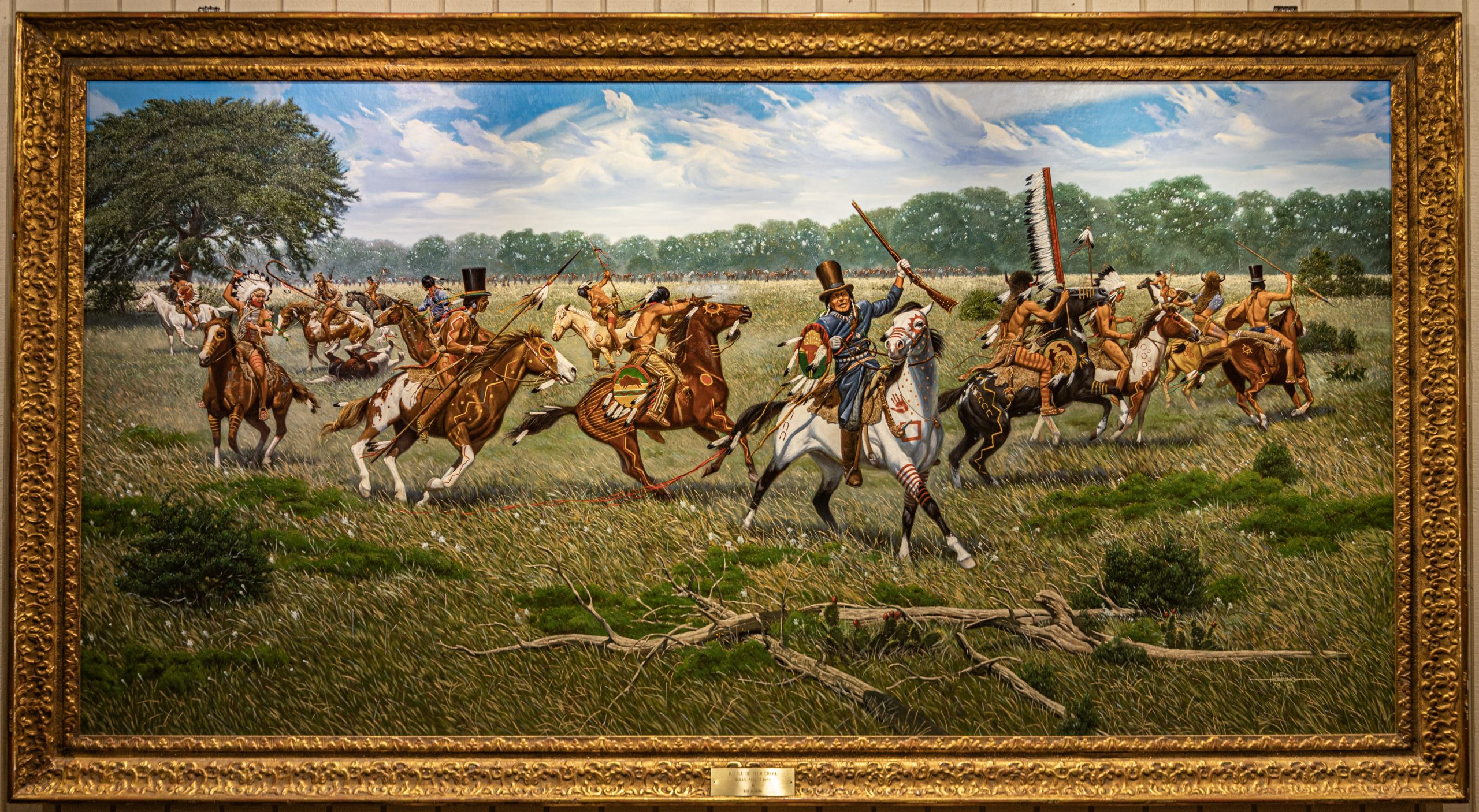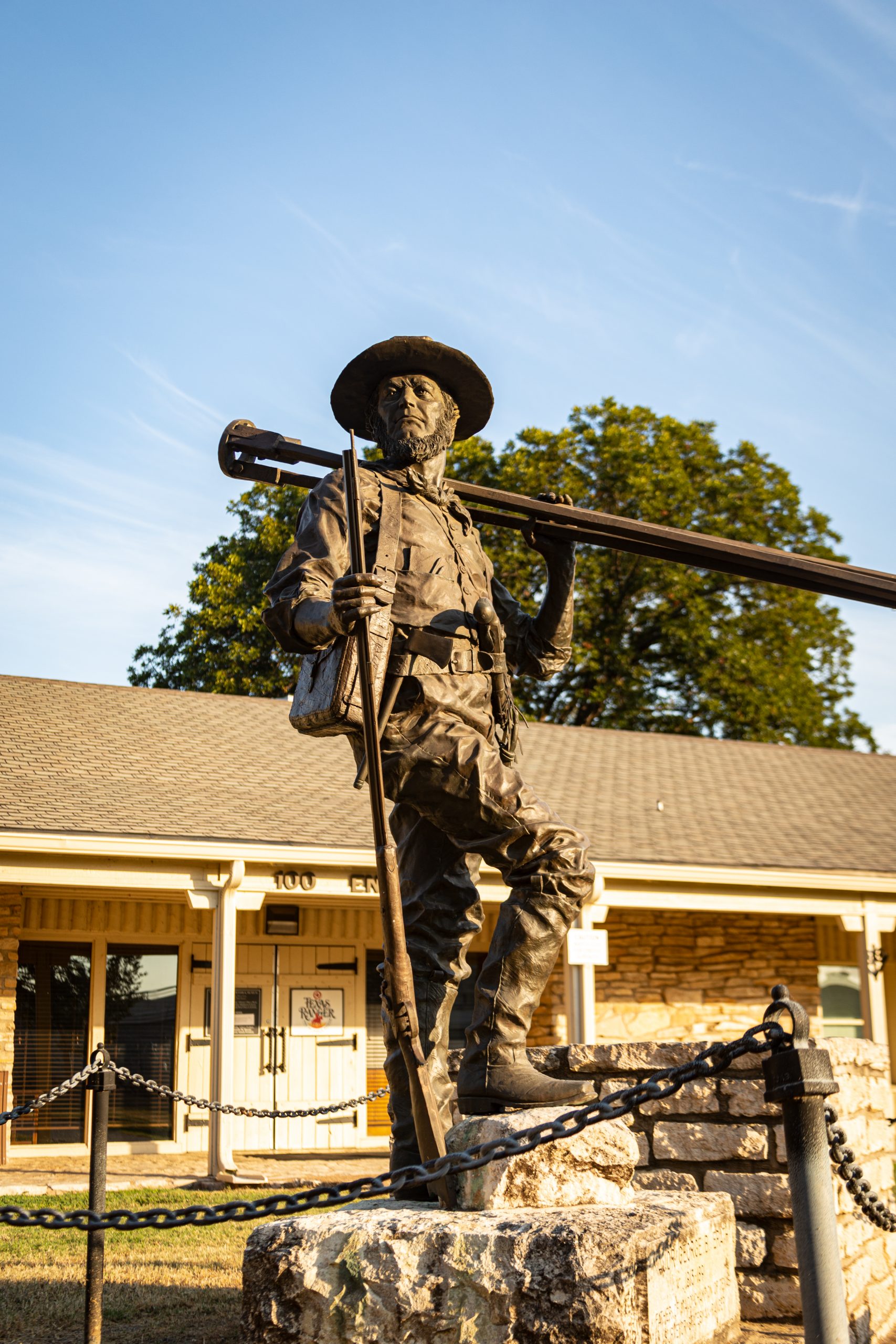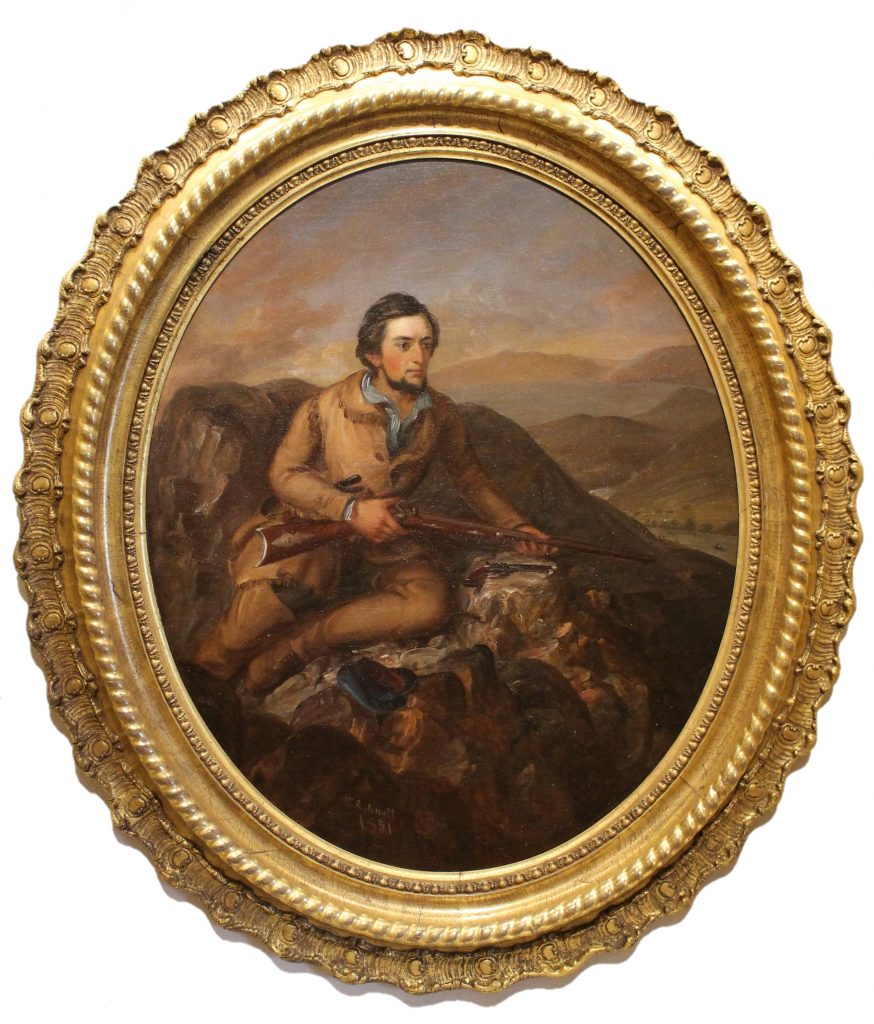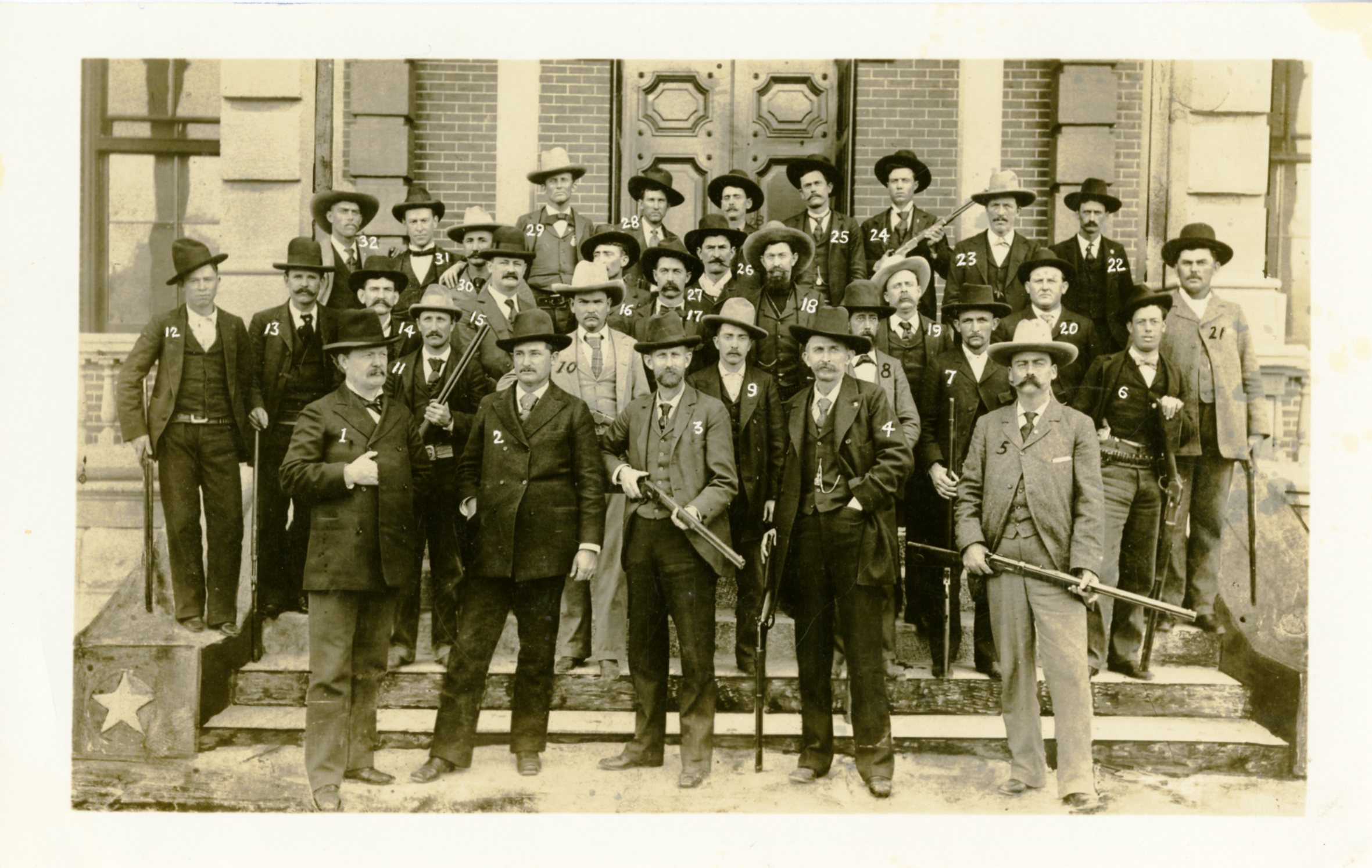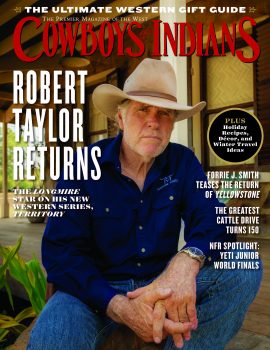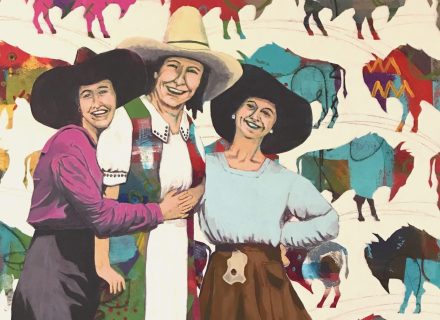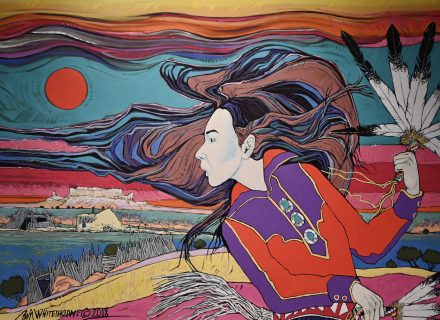To commemorate the bicentennial of one of the world's most iconic law-enforcement agencies, we asked the Texas Ranger Hall of Fame and Museum to curate a special tour for C&I readers. Your tour starts here.
The motto: “No man in the wrong can stand up to a man in the right, who keeps a-comin’.” The badge: a simple circle-star. The reputation: as big as the state they are sworn to protect.
Next to the Alamo, the Texas Rangers might be the most famed element of Lone Star legend. Older than Texas itself, which achieved statehood in 1845, the elite law-enforcement agency figures prominently in the state’s history and outsize identity.
Their mythology fills pop culture. Novels, from Zane Grey’s The Lone Star Ranger (1914) to Reavis Z. Wortham’s contemporary thrillers. Movies, from 1910’s The Ranger’s Bride to 2016’s neo-western thriller Hell or High Water. And then there was the masked man who rode a cool white horse and had a Native American sidekick. First heard on radio in 1933, The Lone Ranger morphed into comic books, a TV series (1949–1957), and movies that forever linked the overture to an opera (William Tell) to a fictional Ranger.
Captain William L. Wright's Winchester 1894 Rifle with Scabbard
Courtesy of W.B. Wright and H.T. Wright / 1320.005
W.L. “Will” Wright (1868–1942) started his life as a cowboy and hired out as a ranch hand at the age of 12 for 50 cents a day. At 21 he joined a cattle drive from Tom Green County, Texas, to Cheyenne, Wyoming. When he returned, he swore he would never leave Texas again because he nearly “froze to death.”
Wright joined the Frontier Battalion in 1898 and continued to serve until 1902. In 1917, after serving for 15 years as sheriff of Wilson County, Wright was appointed Captain of Texas Ranger Company D. During prohibition Capt. Wright’s Rangers were instrumental in capturing bootleggers and smugglers. Wright resigned from the Rangers in 1939.
Capt. Wright sustained only one bodily injury in the line of duty, when he was attacked with a sharpened spoon smuggled out of a jail cell by a condemned prisoner on his way to the gallows. Known for his lightning-fast draw, storytelling, and humor, he was above all known for his self-proclaimed creed to “act impartially without regards to nationality, color, or wealth.”
Texas novelist Larry McMurtry added to the Ranger mystique when his 1985 Pulitzer Prize-winning novel, Lonesome Dove, became a runaway bestseller, led to an iconic 1989 miniseries, and inspired a series of sequels and prequels in print and on TV. Readers and viewers loved retired Texas Ranger heroes Augustus “Gus” McCrae and Woodrow Call. Of the real-life cattlemen those characters were based on — Charles Goodnight/Nelson Story (Call) and Oliver Loving (Gus) — only Goodnight had service, mostly as a scout before the Civil War, with the Rangers. But the fiction memorialized both characters in the American imagination.
Bowie Knife, 1838, Presented to William Lacey by Rezin P. Bowie
Gift of Rudolph Gleichman / 2017.030.001
The Bowie knife, as we know it, is based on 16th-century European hunting knives with the addition of cross guards and a clipped point. At 17 inches, the handle of this knife is believed to be made from segments of buffalo horn. A reinforced mount at the throat of the scabbard is engraved “R.P. Bowie to Capt. Wm. Y. Lacey.” Rezin P. Bowie is credited as the “father of the Bowie knife,” while his brother Jim was known to be proficient with one. 
William Young Lacey (also Lacy) was born in Kentucky in 1814. He came to Texas in 1830 and rode with Jim Bowie, who had also moved to Texas in 1830. Lacey was commissioned into the Corps of Rangers from May of 1836 to December of 1837. After his Ranger service, Sam Houston sent him to Nacogdoches and Houston Counties to form militia companies. Lacey purportedly received the knife from Rezin Bowie in appreciation for his loyalty and service alongside Jim, who died on March 6, 1836, in the Battle of the Alamo, along with other Alamo defenders.
Less rarefied than McMurtry’s work but a powerful force in pop culture, Chuck Norris’ long-running series Walker, Texas Ranger — inspired by one of Norris’ best films, the 1983 western Lone Wolf McQuade — saw him portraying a martial-arts master dispensing morality and justice with a good roundhouse kick. The recent reboot, Walker, featuring Jared Padalecki in the title role, returned for its third season this October, alongside the debut of the prequel Walker: Independence, which walks the TV story of the Texas Rangers back to Wild West days.
That’s the fiction. The truth of the 200-year history is deeper — and sometimes darker.
Texas Ranger Badge, c. 1880s
Gift of Dan Ragsdale / 2584
Made from a Mexican 8-peso coin, this circle-star badge from the late 1880s is considered the earliest authentic style of Ranger badge and was known to be worn by members of Ira Aten's Texas Ranger Company D. The Texas Rangers were organized into two groups following Civil War Reconstruction. The Frontier Battalion (1874–1901) operated statewide, and the Special Forces (1874–1881) were stationed between the Rio Grande and Nueces rivers. Under the command of the Texas adjutant general, Rangers were charged with protecting Texas form Indian and bandit raids. Beginning in the 1880s, each Ranger carried a Warrant of Authority and Descriptive List.
Ranger badges first appeared during the Frontier Battalion Era, when their focus shifted from frontier defense to keeping order in the new settlements. The State of Texas did not supply badges. The few Rangers who wore them before 1900 either commissioned a metalworker to make them or placed an order with a police supply company. The earliest Texas Ranger badges were simple circle-star, shield, or star designs that could be made from 5- and 8-peso Mexican silver coins.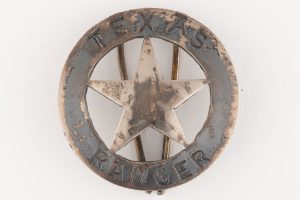
By 1901, the Indian Wars had drawn to a close. The Texas legislature reorganized the Rangers into a new "State Ranger" force with full police powers, allowing them to adapt to emerging challenges, such as organized crime, gambling, and bootlegging. Although badges were not yet issued by the state, many Rangers wore them to identify themselves. Rangers selected their badges based on personal taste and availability, resulting in a wide variety of designs.
In 1935, the Texas Rangers were reorganized as a division of the newly formed Texas Department of Public Safety. For the first time, the state issued badges to the Texas Rangers. Since the formation of DPS, there have been three official styles of Texas Ranger badges. The first style, introduced shortly following the formation of DPS, includes a shield overlaid with a circle-star. In 1957, it was replaced by a blue enameled circle-star design, based on the Lorenzo de Zavala flag of 1836. In 1962, Col. Homer Garrison Jr. approved the design of the current badge, crafted the Mexican 5-peso silver coins for Rangers and lieutenants and 50-peso gold coins for higher ranks. Inspired by early Ranger badges, the current badge is decorated with wreaths of olive and live oaks from the Great Seal of Texas. Personalized styles have also been approved and incorporate the name of the Ranger.
Stephen F. Austin, who would come to be known as the Father of Texas and would give the Rangers their name, had begun bringing families to settle the Mexican province of Tejas in 1821. He had an example to model the fledgling force after. “Since the end of 17th century, units of mounted troopers known as compañías volantes (flying companies) had scoured the Indian trails and haunts across the northern frontier of New Spain, and later Mexico, in an attempt to pursue and destroy native bands. …,” writes historian Dr. Jody Edward Ginn in “The Texas Rangers in Myth and Memory” from Texan Identities: Moving Beyond Myth, Memory, and Fallacy in Texas History. “By the time Anglo settlers began arriving in Texas, Tejanos and their forebears had been serving as specialized mounted frontier counterinsurgency troops for over 140 years. Upon their arrival, Austin’s colonists were given detailed instructions in the formation and operation of traditional Tejano flying companies for purposes of local defense, by both Mexican authorities and their Tejano neighbors.”
Sam Bass $20 Gold Coin, 1877
Museum Collection / 2119
After the death of his father in 1864, Sam Bass was sent to live with an uncle in Mitchell, Indiana. He traveled to Denton, Texas, in 1870 and was hired as a farmhand. In 1874, he began racing horses. Two years later, Bass met Joel Collins and took a herd of cattle to the Dakota Territory. After losing all their money in a saloon venture, the two men turned to a life of crime. They robbed a total of five stagecoaches and rarely received a large payoff. On September 18, 1877, Bass and five other men seized $60,000 from a Union Pacific train in Big Springs, Nebraska. The robbers split the newly minted $20 gold coins, which bore a prominent 1877 date and went their separate ways. Bass continued to stage train robberies in the Dallas area during the spring of 1878, but the payoffs were not large enough. Bass and his gang planned to rob the Round Rock bank in July 1878. Bass was mortally wounded in a gunfight with the Texas Rangers on July 19 but did not succumb to his wounds until July 21, 1878, his 27th birthday.
Austin and his colonists informally applied the terms ranging and rangers to these duties, and within a couple of years, the force boasted more than 300 men. During the 1835–1836 revolution that led to Texas’ independence and throughout the Republic of Texas era (1836–1845), the men would remain a military or quasi-military group that mostly pursued or fought Native Americans. In 1874, they were organized into six companies in camps established along the entire frontier line. According to the Texas State Historical Association, “The work of the Frontier Battalion in making Texas ‘a fairly safe place in which to live’ was largely responsible for the tradition which came to surround the term, ‘Texas Ranger.’”
From those beginnings grew an internationally recognized fighting force, “arguably the most celebrated lawmen in the world, their fame ranking with that of the Federal Bureau of Investigation, Scotland Yard, and the Royal Canadian Mounted Police,” as Charles H. Harris and Louis R. Sadler describe them in their study “The Texas Rangers and the Mexican Revolution.” No small feat for a state-level entity with only a fraction of the personnel employed by those vaunted national organizations.
Major George B. Erath-Frontiersman
Robert Summers
Bronze
Gift of the artist / 2008.034.001
George Bernard Erath was born in Vienna in 1813. He enrolled in Vienna Polytechnic School at a young age to study English and Spanish. To avoid his being drafted into the Austrian military, his family sent him to America. He arrived in New Orleans in 1832, and in 1833, he moved to Mexican Texas and became a surveyor in Robertson’s Colony before joining the Rangers in 1835. He was involved in several fights and skirmishes with the Comanche and fought at the Battle of San Jacinto. After being elected to the State’s First Legislature, Erath returned to surveying and was involved in creating plats of numerous settlements, including laying out the Texas towns of Caldwell, Stephenville, Meridian, and Waco. During the Civil War, he recruited men as a home guard for Brown and Coryell Counties. In later life, Erath was highly respected as an expert surveyor and mentor and became known as the “Walking Dictionary of the Land Office.” He died on May 31, 1891, and is buried in Waco. Erath County is named in his honor.
Over the long course of Texas Ranger history, there have been stellar achievements and horrific incidents. The annals overflow with amazing stories. There are famous enforcers: John Coffee Hays, Samuel H. Walker, Ben McCulloch, William “Bigfoot” Wallace, John B. Armstrong, John B. Jones, Capt. Bill McDonald, Frank Hamer. And legendary enforcing: the foiled assassination attempt in 1909 of U.S. President William H. Taft and Mexican President Porfirio Díaz in El Paso, Texas. The capture of outlaw gunfighter John Wesley Hardin on a train in Pensacola, Florida. The ambush of train-robbing gang leader Sam Bass in Round Rock, Texas. The bloody roadside end of Bonnie and Clyde in Bienville Parish, Louisiana. The negotiated surrender of prolific “Railroad” serial killer Angel Maturino Reséndiz at the El Paso bridge. The investigation into the tragic 1993 siege of the Branch Davidians in Waco, Texas. The gunfight rescue of a kidnapped 2-year-old girl in Horseshoe Bay, Texas. The 1991 mass shooting at a Luby’s Cafeteria in Killeen, Texas. The 1997 standoff with Republic of Texas separatists in the Davis Mountains.
The record is not unblemished. There has been controversy and even crime, including shocking incidents like the 1918 Porvenir Massacre, in which 15 unarmed men and boys were executed en masse by Texas Rangers, U.S. Army soldiers, and local residents outside the village of Porvenir in Presidio County, Texas. The act is now commemorated with an Undertold Stories Historical Marker at the site.
Jack Hays at Enchanted Rock, 1851, Oil on Canvas, W.S. Jewett
Gift of Roblay McMullin / 1998.024.001
The legend of 1840s Texas Ranger Capt. Jack Hays at Enchanted Rock is that in the fall of 1841, Hays was cut off from his company of Rangers by several Comanche. hays sought refuge at Enchanted Rock and single-handedly held off the Comanche until his men could find and rescue him. According to information from the Hays family, this 1851 painting by W.S. Jewett commemorating the incident was commissioned by the captain's wife, Susan, while they were living in San Francisco. Although the artist took many liberties with the landscape of the Texas Hill Country, the representation of Hays in accurate.
The Rangers’ reputation suffered most during James E. “Farmer Jim”/”Pa” and Miriam “Ma” Ferguson’s terms as Texas governor (he served from 1915 until his impeachment in 1917; she served as his stand-in from 1925 to 1927 and from 1933 to 1935). “She fired the good Rangers — or they resigned — and appointed mostly lesser lights, including some with criminal records,” says Mike Cox, author of five nonfiction books about the Rangers and a former spokesman for the Department of Public Safety, which oversees the Rangers. “Until the creation of the Texas Department of Public Safety in 1935, the Rangers were always subject to politics and gubernatorial whim. Ma and Pa’s mostly corrupt and largely incompetent Ranger force was one of the factors that contributed to the organization of a more professional, mostly apolitical force.”
Colt Single Action Army Revolver once belonging to outlaw Alvin Odle
Gift of Joseph Trobaugh II / 2022.028.001
Colt Single Action Arm revolver with engraving throughout, manufactured 1885. With small note concealed in the grip written by Cal Aten. The note reads: "Taken from hand of Alvin Odle as he lay dying at the East Fork of Bullhead Mt. Edwards Co., TX. Xmas night 1889."
 Calvin Aten came to Texas as a young child with his family in 1876. Following in older brother Ira's footsteps, he enlisted in Company D of the Texas Rangers on March 24, 1888, under Capt. Frank Jones. His dangerous and adventurous time with the Rangers included working along the border in far South Texas and also in the Big Bend region. One of the most electrifying episodes of Aten's Ranger career unwound in the Texas Hill Country near present-day Rocksprings. There, on Christmas night 1889, while accompanied by Rangers John R. Hughes and Bazel Lamar "Baz" Outlaw, Aten was involved in a fierce gunfight with fugitives Will and Alvin Odle, who were well-known for numerous crimes as well as trafficking stolen livestock across the border into and out of Mexico. The Odle brothers were killed, and as Alvin Odle lay dying, he gave his engraved Colt .45 six-shooter to the young Ranger comforting him.
Calvin Aten came to Texas as a young child with his family in 1876. Following in older brother Ira's footsteps, he enlisted in Company D of the Texas Rangers on March 24, 1888, under Capt. Frank Jones. His dangerous and adventurous time with the Rangers included working along the border in far South Texas and also in the Big Bend region. One of the most electrifying episodes of Aten's Ranger career unwound in the Texas Hill Country near present-day Rocksprings. There, on Christmas night 1889, while accompanied by Rangers John R. Hughes and Bazel Lamar "Baz" Outlaw, Aten was involved in a fierce gunfight with fugitives Will and Alvin Odle, who were well-known for numerous crimes as well as trafficking stolen livestock across the border into and out of Mexico. The Odle brothers were killed, and as Alvin Odle lay dying, he gave his engraved Colt .45 six-shooter to the young Ranger comforting him.
Aten kept the revolver under his mattress the remainder of his life; to ensure the story would not be lost upon his death, he penciled a tiny note and placed it inside the pistol's wooden grips.
Following his tenure with the Texas Rangers, Aten became a cowboy on the XIT Ranch, later acquiring a cattle ranch of his own near Adrian, Oldham County, where he registered the 8N brand.
Today, out of the more than 100,000 sworn law enforcement officers in Texas, only 166 are Texas Rangers. The ranks have included women since 1993, when Cheryl Campbell and Marrie Reynolds Garcia became the first female Rangers. With statewide jurisdiction, the agency makes it headquarters in the state capital of Austin. But the best place to explore in-depth can be found midway between Austin and Dallas in Waco, home of the Chip and Joanna Gaines Magnolia/Silos juggernaut, Baylor University, and the Texas Ranger Hall of Fame and Museum.
Lone Ranger Black Mask custom-made for Clayton Moore
Gift of Elizabeth Mahon in Memory of Dolores Taylor, M.D. / 2009.054.260
Perhaps the best known of the Lone Ranger actors is Clayton Moore (1914–1999). Before becoming the Lone Ranger, Moore worked as a circus acrobat and aerialist, model, stuntman, and bit player in Hollywood. By late 1938, he was an actor in B westerns and played the lead in several serial cliffhangers in the 1940s and 1950s. In World War II, Moore served in the U.S. Army Air Force and made training films with the First Motion Picture Unit. In 1949, Moore was signed to play the Lone Ranger on television. He left the production in 1952 but returned the following year to continue portraying the "masked man." In all, he starred in 169 episodes. He and Jay Silverheels, as Tonto, also starred in two feature-length Lone Ranger movies. For more than 40 years following the close of production, Moore continued to both portray the Lone Ranger and promote Ranger "ideals" in personal appearances, TV guest spots, and commercials.
Rated one of the country’s 10 best halls of fame by USA Today and the recipient of a 2022 TripAdvisor Visitor’s Choice Award (among many other accolades), the Ranger Museum opened in 1968 at Fort Fisher, an original 1837 Ranger site. It was initially called the Homer Garrison Texas Ranger Museum, after Col. Homer Garrison Jr., longtime director of the Texas Department of Public Safety and chief of the Texas Rangers. In 1976, an expanded museum, now with a library and research center, was renamed the Texas Ranger Hall of Fame and Museum. Since its opening, more than 2 million people have visited and perused the growing collection of approximately 20,000 artifacts and works of art spanning three centuries. The collection includes clothing, badges, firearms, field gear, forensic investigation equipment, historic and modern paintings, sculptures, and folk art relevant to the Texas Rangers and Texas. The biggest draws? Clayton Moore’s Lone Ranger mask and the earliest known Texas Ranger badge.
Beyond the museum, the real story continues wherever the Rangers deploy. You’ll find them fighting major violent crime and public corruption, investigating cold cases and officer-involved shootings, and overseeing border security.
The badge. The motto. The reputation. Two hundred years later, the Texas Rangers ride on.
Continue your Texas Rangers tour here with Dr. Jody Edward Ginn's article "The Texas Rangers in Myth and Memory" and get recommendations for places to visit, books to read, and movies to watch in commemoration of the bicentennial. To learn more, visit texasranger2023.org and texasranger.org.







